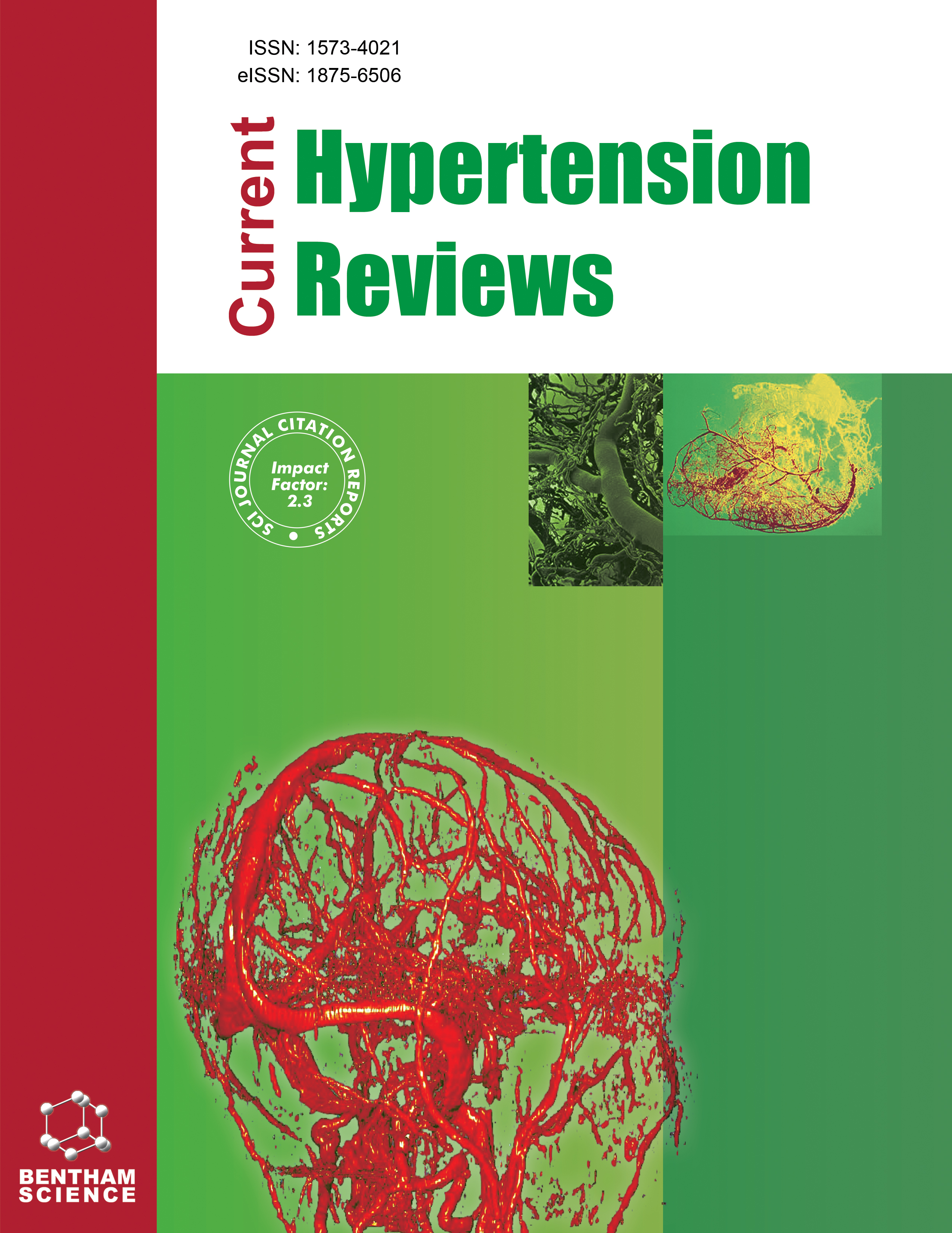- Home
- A-Z Publications
- Current Hypertension Reviews
- Previous Issues
- Volume 4, Issue 3, 2008
Current Hypertension Reviews - Volume 4, Issue 3, 2008
Volume 4, Issue 3, 2008
-
-
Pulmonary Hypertension in the Critically Ill
More LessAuthors: Michelle S. Chew, Lill Bergenzaun, Hans Ohlin and Anders ErssonPulmonary hypertension is not uncommonly seen in the critically ill. It may be encountered in patients with pre-existing diseases or may occur acutely without predisposing conditions. The diagnosis and management of pulmonary hypertension can be very challenging, given that critically ill patients are often concurrently haemodynamically unstable. Commonly used therapies in the Intensive Care Unit, such as fluid resuscita Read More
-
-
-
Role of WNK Kinases in Blood Pressure Control
More LessAuthors: Sung-Sen Yang, Shih-Hua Lin and Chou-Long HuangWith-No-Lysine [K] (WNK) kinases are a group of serine/threonine protein kinases with an unusual location of the catalytic lysine. There are four mammalian WNK kinases, WNK1-4, each encoded by a separate gene. In addition, WNK1 has two alternatively spliced isoforms: a ubiquitously expressed full-length long isoform (L-WNK1) with kinase activity and a kidney-specific isoform (KS-WNK1) lacking kinase activity. Mutatio Read More
-
-
-
A Comparative Literature Review Exploring Hypertension Drugs that Lower Target Organ Damage Above and Beyond Reducing Blood Pressure Based on Research Studies Between 1992 and 2006
More LessAuthors: Ehte Bahiru and Robert A. KlonerApproximately 65 million individuals in the United States suffer from systemic hypertension. Hypertension leads to various cardiovascular diseases including myocardial infarction, stroke, kidney disease, and others. Hypertension is commonly linked to other risk factors for cardiovascular diseases such as diabetes, dyslipidemia, and smoking. For this study, we reviewed 24 recently published papers that compared different Read More
-
-
-
Emerging Roles for Connexins in Hypertension
More LessThe current pharmacological arsenal for treating hypertension includes diuretics, inhibition of the Renin- Angiotensin-Aldosterone (RAA) cascade and alpha blockade, often with inadequate results. Gap junction proteins, connexins (Cx), are ubiquitously expressed in organs involved in the pathogenesis of hypertension, namely brain, heart, vascular bed and kidney. Central to hypertension is increased vasomotor tone, itself Read More
-
-
-
Five Markers Capable to Identify Passive Smoking Exposure Associated with Endothelial Dysfunction in Healthy Individuals
More LessBy the analysis of our previous studies, functional and biochemical markers related to ETS exposure are discussed. 18 healthy never smokers, 12 men (67%), 6 women (33%), 21 to 55 years old (mean:34+/-9 ys.) underwent twice - in a smoking free environment and in the same environment polluted by 35 ppm carbon monoxide from cigarette smoking- brachial artery ultrasonography, exercise stress testing, heart rate (HR) a Read More
-
-
-
Role of ERK1/2 Activation In Thrombin-Induced Vascular Smooth Muscle Cell Hypertrophy
More LessAuthors: Esma R. Isenovic, Andreja Trpkovic, Zorica Zakula, Goran Koricanac and Pierre MarcheIt is well recognized that the proliferation of vascular smooth muscle cells (VSMCs) is a key event in the pathogenesis of various vascular diseases, including atherosclerosis and hypertension. It is generally considered that the phosphorylation/dephosphorylation reactions of a variety of enzymes belonging to the family of mitogen-activated protein kinases (MAPKs) play an important role in the transduction of mitogenic signal. We Read More
-
-
-
The Roles of Abnormal Renal Sodium Handling in Hypertension Associated with Metabolic Syndrome
More LessAuthors: George Seki, Hideomi Yamada, Yuehong Li, Shoko Horita, Masashi Suzuki and Toshiro FujitaThere is an epidemic of the metabolic syndrome across the world, which is often associated with hypertension and other coronary risk factors. Insulin resistance is thought to play a key role in this condition. Several different mechanisms such as activation of renin-angiotensin system, enhancement of sympathetic nerve system, and hyperinsulinemia may underlie hypertension in metabolic syndrome. Unlike in other tiss Read More
-
-
-
The Reservoir-Wave Paradigm: Potential Implications for Hypertension
More LessAuthors: John V. Tyberg, Nigel G. Shrive, J. C. Bouwmeester, Kim H. Parker and Jiun-Jr WangConsistent with a straightforward, time-domain interpretation of Westerhof's classic circuit diagram of the 3- element Windkessel, we have concluded that measured aortic pressure is the instantaneous sum of a constant (P∞), a Windkessel/reservoir pressure, and a wave-related pressure. According to our interpretation, the resistive element interposed between the left ventricle and the resistance-capacitance (R Read More
-
-
-
Blood Pressure Management in Metabolic Syndrome
More LessAuthors: Yuichiro Yano, Satoshi Hoshide, Kazuyuki Shimada and Kazuomi KarioTo assess 24-hour BP levels in subjects with metabolic syndrome is essential, because hypertension, which is the most prevalent component in the syndrome, makes the major contribution to cardiovascular risk. Because BP levels in subjects with metabolic syndrome are prone to be elevated in an out-of-office setting (i.e., nocturnal hypertension, morning hypertension), measurement of home and/or ambulatory BP levels is a pro Read More
-
Volumes & issues
-
Volume 21 (2025)
-
Volume 20 (2024)
-
Volume 19 (2023)
-
Volume 18 (2022)
-
Volume 17 (2021)
-
Volume 16 (2020)
-
Volume 15 (2019)
-
Volume 14 (2018)
-
Volume 13 (2017)
-
Volume 12 (2016)
-
Volume 11 (2015)
-
Volume 10 (2014)
-
Volume 9 (2013)
-
Volume 8 (2012)
-
Volume 7 (2011)
-
Volume 6 (2010)
-
Volume 5 (2009)
-
Volume 4 (2008)
-
Volume 3 (2007)
-
Volume 2 (2006)
-
Volume 1 (2005)
Most Read This Month
Article
content/journals/chyr
Journal
10
5
false
en


